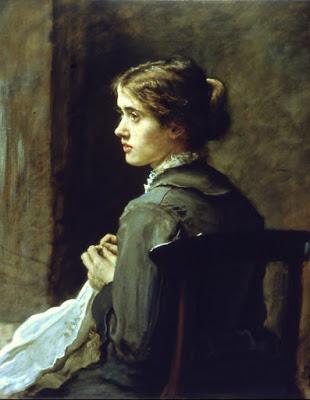
Stitch! Stitch! (1876) John Evertt Millais
Now, I don’t have to tell you that the lot of a seamstress was not a happy one.It was well known that women who sewed often did so because they were widowed or orphaned and had children to support.Home-sewing ensured you could mind your little ones while making money, however the sums involved were pitiful.Thomas Hood wrote his famous poem ‘The Song of the Shirt’ in response to the sad case of Mrs Biddell, who sewed trousers and shirts for an employer who provided the materials for a £2 deposit (that’s around £100 in today’s money).Mrs Biddell could probably expect a couple of pence pay per item and would no doubt have to pay for her own needles and thread out of that.On the brink of starvation, Mrs Biddell pawned several of the items she had sewn and was sent to the workhouse in debt.So moving was this account that Hood’s poem seems as a siren call to end such inhuman labour:
Art at the time turned to reflect this struggle, showing women sewing in sad little rooms, poor and desperate.Whilst feminine sewing had been seen as a proper pastime for lovely ladies, it became more apparent that for some it was matter of life and death, most probably death.‘Stitch – stitch – stitch,In poverty, hunger and dirt,Sewing at once, with double thread,A shroud as well as a shirt.’
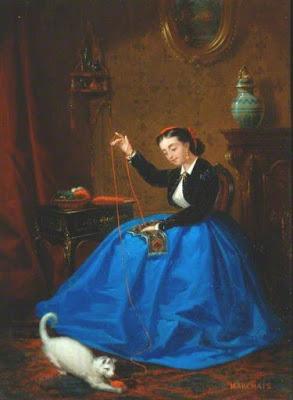
What Victorian Men think I do...
(Girl in a Blue Skirt, Sewing J B Marchais)
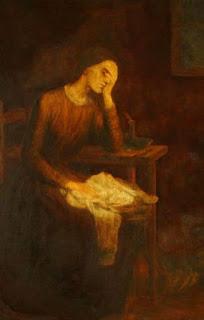
What I actually do...
(Song of the Shirt (1850) G F Watts)

Widowed and Fatherless (1888) Thomas Kennington
When Mr Lockyer died in 1898 all that changed.Emily was unmarried and she and her mother obviously could not afford to keep a house of their own.They appear in the 1901 census, living with their son-in-law, who was a postman and head of his own sizable household.It seems unsurprising that they had to move into rooms of their own, but it does not seem to be an upward move.The rooms were described as ‘miserable and squalid’ (a more honest way of saying ‘a property with character’, possibly…)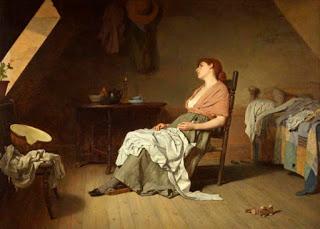
Song of the Shirt (1877) Edward Radford
They worked for Shadrac, Schneider and Sons, a wholesale clothing manufacture of Durward Street, Bethnal Green.Emily seems to have been the main employee because it was she that took in the pairs of trousers for ‘finishing’.Finishing entailed a sewer putting on buttons, hemming the garment, sewing in bands and pockets and that sort of thing.For each garment ‘finished’ the women received 2d, which equates to around 48p of today’s money.When several of the pairs of trousers did not arrive back at Shadrac, Schneider and Sons in October 1902, they sent the police round to Ann and Emily’s rooms and found the pawn tickets relating to four pairs that Ann had taken to the pawnbroker.The two women were hauled up in court on 15thOctober 1902 and it was reported in the Daily News the day after.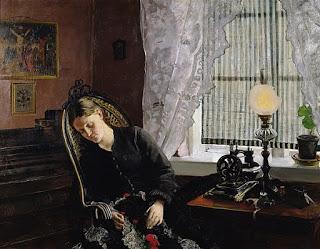
The Seamstress (1881) Christian Krohg
Under the headline ‘STITCH! STITCH!! STITCH!!!’, the paper spoke of the pair’s ‘pitiable appearance of poverty’s struggles’ and how they ‘wailed out their defence’.Emily was reported as saying ‘We had no food.’ Her mother added ‘It is slow starving to work on these things at 2d and 2¼d a pair.We did it to get food and light.’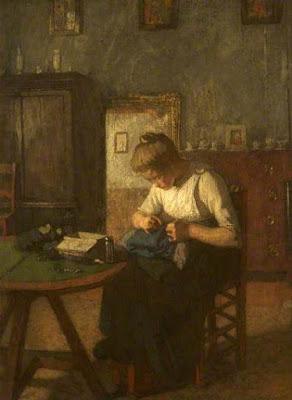
The Young Seamstress (1907) Harold Knight
Such emotional pleas fell on deaf ears.In response the Magistrate, Mr Cluer (probably not on 2d per case) said ‘it might be starvation, but it was not sense to throw away the chance of earning even the small sum they got.’ They were each ordered to pay 10 shillings, an equivalent of around £28 or serve five days in prison for unlawful pawning.They were taken off to prison because where on earth would they get 10 shillings from?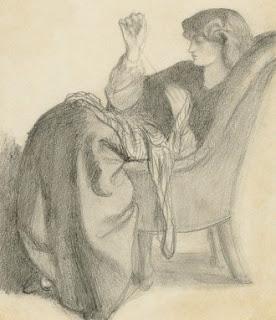
Jane Morris, seated in a chair, sewing (1860s) Dante Gabriel Rossetti
Enter the reason I came across the story.Reading the Daily News on Thursday 16 October 1902 was another woman, famed for her talent with a needle.She was so horrified by the plight of the women that she wrote immediately to the newspaper:
Sir,I enclose 10s towards paying the fine to extricate those two poor needlewomen sentenced at Worship-street court, as reported in your issue of yesterday, Oct. 16.Yours etc. (Mrs) Jane Morris, Kelmscot (sic) Manor, Lechlade, Oct. 17, 1902The reason I found this so surprising and touching is because we often think of Jane as quite aloof and uninvolved in real life.While her daughters and husband held the Socialist banner high, Jane is conspicuous by her absence and it has struck people as noteworthy that she did not involve herself as wholeheartedly as May, for example, in pursuing and upholding her husband’s principles.
[The above has been sent to the Court Missionary. – Ed. D.N.]
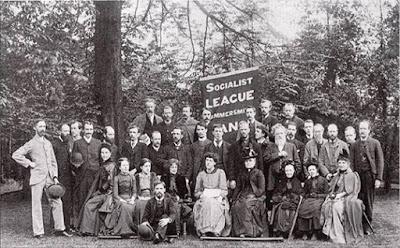
Hammersmith Socialist League, with William, May and Jenny Morris present
Little did I suspect that Jane favoured a bit of direct action and in freeing at least one of the women (possibly both with time served) and broadcasting her actions publically in the newspaper, she might have highlighted the continuing plight of needlewomen which does not seem to have improved a jot since Mrs Biddell in 1843.It could be that she was purely motivated by the awful plight of the women, it could be that her husband’s socialism had also been her own, but it could also have been that she was smart enough to realize that whilst she had the luxury and time to do this…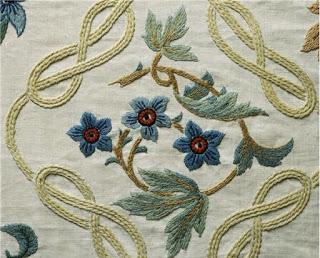
Detail of Bedcover (1910) Jane and May Morris
…others were also sewing, but in ‘slow starving’ and squalor.Whatever her reasons I think I appreciate Jane Morris a little bit more today because of it.

